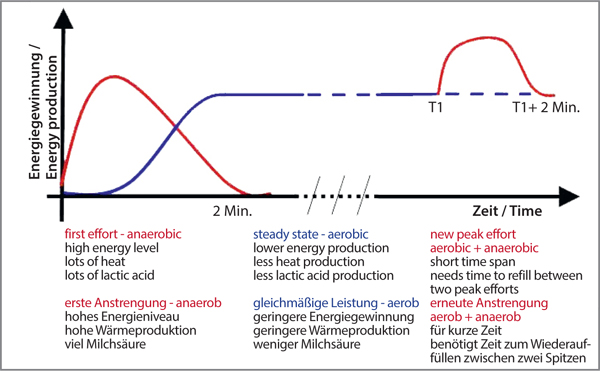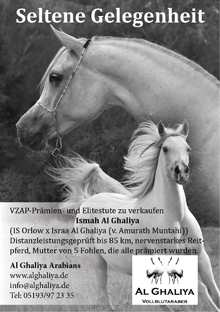Training the Endurance Horse (II)
In this part about training the endurance horse, we have a look at the use of the two energy-production systems and how they are provided with fuel and oxygen.
In the previous issue we have seen that two different chemical processes contribute to the energy supply of the body:
1) the aerobic (with the use of oxygen) “burning” of body fat in energy or
2) the anaerobic (without the need of oxygen) transformation of fuel, which was stored within the muscle in a chemical form, which is readily transformable into energy.
Each system has its advantages and inconveniences, which limit their use. In summary:
Aerobic:
- steady-state, long use, little heat-production, little lactic acid production
- slow shift to higher production level needs increased heart beat frequency (HBF) and increased respiratory frequency (RF)
Anaerobic:
- immediately available
- low efficiency, stored fuel is limited in quantity, high heat-production, high lactic acid production.
During any real effort, the two energy production systems work together and the aerobic system is progressively taking over from the anaerobic system, which is needed for an immediate start.
Anaerobic Energy to give a Boost
The use of the anaerobic energy production for a couple of minutes at the start has depleted the fuel, which was initially stored in the muscles. As it is always “safe” to have the possibility to ask for another peak of energy (i.e. delivered by the anaerobic process), it is necessary to replete the “stored fuel” in the muscles to its maximum quantity. Thus a part of the aerobically produced energy during the following steady-state effort will be transformed in the muscle to the chemical form we called “stored fuel”.
To make this possible, the horse cannot work at the maximum level of the aerobic energy production for a while, i.e. we need to ride at a calmer pace. This calmer period will be necessary after each “peak-effort”, if we want the horse to be ready for another “peak-effort” when required.
During the period of calmer work, the excess heat and lactic acid produced during the peak-effort can be excreted. It is important, that the excess heat and lactic acid, produced by several successive peak-efforts (anaerobic) does not accumulate without giving the body a chance to ‘clean’ the muscle in between.
The period of time which the horse will need to recover from the “damage” caused by the ‘slightly too long’ use of the anaerobic energy-production or the ‘too frequent’ successive peak-efforts on top of the steady-state effort will depend on how close to the top-capacity of the aerobic maximum aptitude we work at that moment. The calmer we work, thus leaving the margin between the highest possible production of aerobic energy and the energy the horse consumes during this calmer period, the faster the muscles will be cleaned and the fuel storage being refilled.

During the Ride
From the above, it is clear that in endurance, we ideally prefer to use the aerobic system of energy production for the majority of the ride and only use the anaerobic system now and then when a sudden peak of energy is needed (sudden deep going or sudden change in slope during which we don’t want to slow down for one or another reason, passing by another rider without slowing down just in front of him, during final sprint, etc.).
When starting the ride, we can:
– either start very progressively during the first two minutes to give the aerobic system the time to start up (increase of HBF and RF) progressively without the need of the anaerobic energy supply. This is hard to realise in a “mass-start” and will only be used for individual starts in “training rides” (rides of 80 km and less).
– or “warm up” before the start of the ride, as far as metabolism is concerned, to allow for a progressive increase of the effort and including a peak effort. This will make use of anaerobic energy and stimulates the start-up of the aerobic system at a high level of production. This first stage of warming up has to be followed by a calmer period allowing to replete the stored fuel in the muscles and get rid of the heat and lactic acid produced by the peak-effort.
Approximately two minutes after the first intensive effort has been required, the aerobic energy supply is ready to function on full power.
The maximum produced aerobic energy depends at any moment on the available transported oxygen as well as on the amount of fuel (in this case stored as body-fat somewhere in the body). The fuel does not come from just previously eaten and digested nutrients! (see the chapter on nutrition, part 3).
The aerobic process has a much higher efficiency (more energy is produced from same quantity of “fuel”) and produces far less lactic acid and less heat. The “excretion system” of the horse (blood-circulation and urinary system) normally copes very well with this lower quantity of lactic acid and heat produced as by-products.
This process can go on for a longer time, without poisoning the muscles, as long as enough oxygen is arriving and enough fuel is available (transported by the blood-circulation from where it is stored body-fat). This mechanism can go on indefinitely as long as we work in a kind of “steady-state” system where consumption of fuel and oxygen remains below its supply by the blood.
Training Lungs?
During higher level of aerobic energy production, supplying the needed quantity of oxygen requires an increase of the respiratory frequency.
Contrarily to what is suggested by the common saying “training lungs and heart”, the capacity of the lung as an organ cannot be trained. Their surface of absorption (alveoli) and of exchange of oxygen with the blood, can not be increased. On the contrary, this surface can nothing but decrease during the lifespan of a horse. Indeed, each respiratory pathology at any time, of its “history”, be it bacterial, viral or fungal, destroys part of the lung-cells, thus being lost forever as functional lung-surface. It is therefore paramount to protect the lungs of the foal/youngster/athlete against all respiratory diseases and also against worms (red worms in particular) during its whole life (hence the importance of breeding management of “sport”-intended foals).
So, the quantity of oxygen made available by the lungs can only be increased by the increase of the respiratory frequency upon demand.
Metabolic Adaptations
Intensive transport of fuel and oxygen to the muscles requires an increase in blood-circulation. Contrary to the surface of the alveoli of the lungs, the capacity of the transport-system (blood circulation) is very trainable.
This will be achieved by several metabolic adaptations in the body:
1) an increased heart beat frequency will circulate the blood with higher “turn-over”;
2) training the capacity of the “pump” (the heart) will increase the quantity of blood and the speed of the flow;
3) the quantity of oxygen transported by the blood: As the oxygen molecules (made available by the lungs) are attached to the wall of the red-blood-cells, which act as “carriers”, the numbers and efficiency of the red blood-cells will determine the quantity of oxygen-molecules transported. Therefore, upon demand of the muscles that need more oxygen for the aerobic process, contractions of the spleen will release an extra quantity of red blood-cells (which are stored there).
The quantity of red blood-cells available in the spleen and the peak of their efficiency, varies with the physical condition of the horse and is subject to improvement by training.
It thus appears that the work a horse can do with the help of the aerobic energy supply will depend on the capacity of the lungs and heart to provide for transport and the blood-cells to carry the oxygen to the muscle to “burn” all the fuel available. This total capacity is very trainable and all the different elements should be trained properly.
How to train these mechanisms?
The aim when training a horse is essentially three-fold :
a) the basic training increases the resistance of all the supporting parts of the body so they don’t get damaged during the effort
b) the body-building or power-training intends to increase the volume of muscles where the quickly available and fast transformable fuel is being stored, allowing for more intensive anaerobic efforts (during short duration efforts …) and the improvement of the excretion of the excessively produced lactic acid and heat (see: excessive sweating of flat-racing sprint horses).
c) the metabolic training increases the level at which we can work in steady-state aerobic energy supply. This is the quickest and shortest, but most delicate part of training of a horse capable of enduring long efforts.
Nelly Philippot-Hermanne














